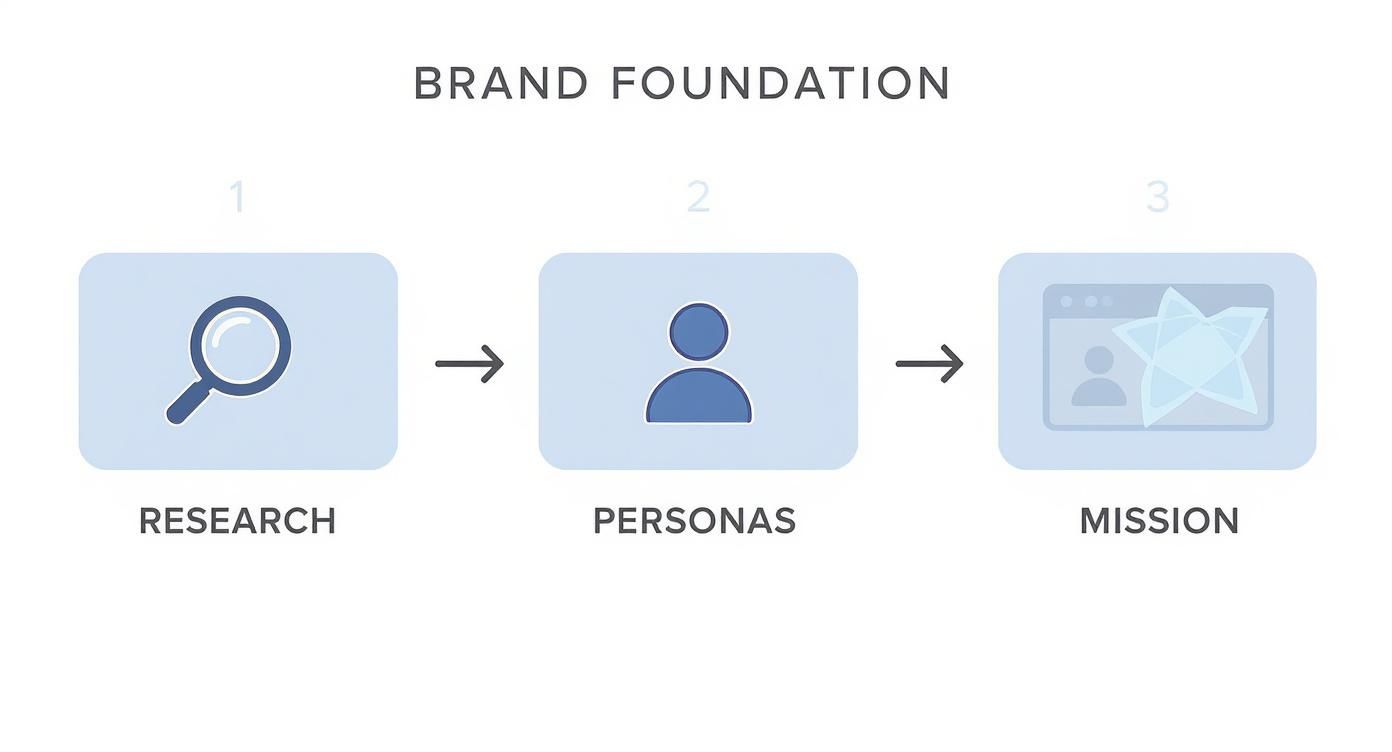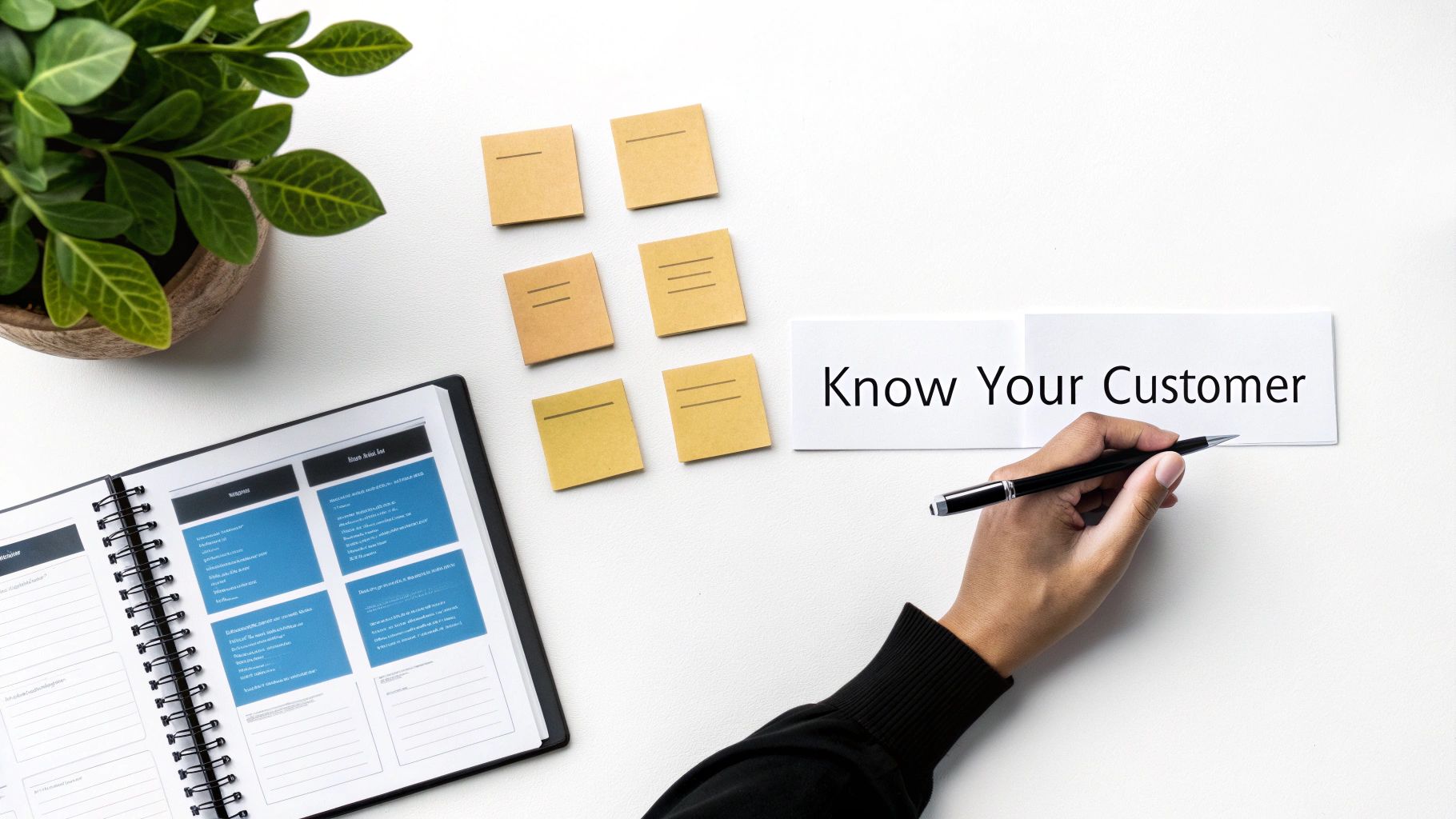Stay Updated with Everything about MDS
Thank you! Your submission has been received!
Oops! Something went wrong while submitting the form.

Chilat Doina
November 12, 2025
To build an ecommerce brand that actually lasts, you have to get the foundation right. That means defining its core identity long before you even think about a logo or website design. This is the deep work: market research to find a profitable niche, creating customer personas that feel like real people, and writing a mission statement that means something.
Honestly, this foundational work is the difference between a memorable brand and a forgotten online store.
Jumping straight into design is one of the most common—and costly—mistakes I see new entrepreneurs make. A compelling brand isn't just a pretty logo; it's the entire feeling you create for your customer. It’s how you answer the big questions: Who are we? Who do we serve? And why should they care?
To get this right, you need to understand what branding truly means. Think of it as the strategic blueprint that informs every single decision you make, from product development to your marketing messages. Without this clarity, your efforts will feel disjointed and, frankly, they just won't connect with your audience.
First things first: carve out your specific space in the market. Trying to sell everything to everyone is a recipe for getting lost in the noise. Instead, get laser-focused on a well-defined niche.
Ask yourself what problems you can solve or passions you can serve. Are you targeting eco-conscious parents? Minimalist tech enthusiasts? Maybe home chefs who are obsessed with rare spices? A narrow focus lets you become the go-to expert. It makes your marketing so much more effective because you know exactly who you're talking to and what makes them tick. Do some digging into trends, look for underserved audiences, and find where your own passion meets a real market need.
Once you've got your niche, you need to get inside the heads of the people in it. Buyer personas are basically semi-fictional profiles of your ideal customers. Don't just stop at demographics like age and location—that’s surface-level stuff. You have to go deeper.
Give your persona a name, like "Eco-Conscious Elena." It sounds simple, but it makes them feel real and helps you create marketing that speaks directly to them, not at them.
This infographic breaks down the flow from broad research to a focused brand mission.

As you can see, each step builds on the last, making sure your mission is grounded in a real understanding of your customer.
Your mission statement is your brand’s north star. It’s a short, punchy explanation of your company's purpose. It should get your team fired up and make your customers feel like they're part of something bigger. It's not just what you do, but why you do it.
Your positioning statement, on the other hand, is more externally focused. It clearly defines where your brand fits in the market compared to your competitors. For a masterclass in how this is done, check out these powerful brand positioning statement examples to see how successful companies own their space.
To wrap this section up, I've put together a simple checklist to make sure you've covered all your bases.
This table summarizes the core components we've just discussed. Think of it as your go-to reference to ensure you're building your brand on solid ground before moving on to the more visual elements.
Getting these pieces right from the start isn't just busywork; it's the most important investment you can make in your brand's future. It builds the kind of authenticity that customers can feel, and that's what turns them from one-time buyers into lifelong fans.

Okay, you've done the heavy lifting and laid down your brand's strategic foundation. Now for the fun part: giving it a personality. This is where you take all those abstract ideas—your mission, your values—and turn them into something your audience can actually see, read, and connect with.
Get this right, and your brand becomes instantly recognizable, even in a crazy-crowded market. This isn't just about picking a trendy color or a clever name. It's about building a whole system of visual and verbal cues that all work together to tell the same story.
Picking a brand name feels like a huge decision, because it is. A great name is catchy, easy to say, and gives a little nod to what you do or the feeling you want to create. Think of names like "Allbirds" for its natural shoe materials or "Bombas," which playfully references community and their buy-one-give-one model.
But before you get too attached to a name, you absolutely have to do your homework. This part is non-negotiable.
Seriously, don't rush this. Brainstorm with your team, say the names out loud, and make sure you choose something that can grow with you.
Your visual identity is your brand's handshake. It's that first impression, and it happens in a split second. In fact, research shows that a consistent signature color can boost brand recognition by a whopping 80%. Consistency is everything here; it builds trust and makes you memorable.
Let's break down the core pieces:
In e-commerce, your imagery is a huge part of your visual identity. From website banners to product shots, high-quality visuals are essential. If you want to really nail this, check out this fantastic guide on product photography for ecommerce to get your shots looking professional.
Key Takeaway: A strong visual identity isn’t just about aesthetics. It’s a strategic tool that instantly communicates your brand’s values and helps you stand out in a sea of competitors.
Last but not least, how does your brand sound? Your brand voice is the personality that shines through in every word you write, from your website copy to your social media captions and customer service emails.
Are you funny and casual? Or are you more buttoned-up and professional?
Whatever you decide, stick with it. It’s jarring for a customer to see a playful Instagram post and then get a stiff, corporate-sounding order confirmation. To keep everyone on the same page, especially as you hire more people, you need to write it all down. Creating brand guidelines is the best way to do this. For a step-by-step walkthrough, our article on how to create brand guidelines has you covered.

Your website is where your brand promise gets real. Think of it as your digital storefront. All the hard work you’ve poured into your brand strategy can fall apart in an instant with a clunky, confusing site. This is that make-or-break moment when a customer decides if you’re the real deal.
A great user experience isn’t just a nice-to-have; it's how you build an ecommerce brand that people actually trust and come back to. Every single click, page load, and product photo shapes how customers feel about your business. When you give them a seamless journey, you're showing them you respect their time and value their business.
Thinking your mobile site is just a shrunken-down version of your desktop site is a rookie mistake. A huge chunk of your customers—likely the majority—will find and shop with you on their phones. Your entire design process has to start there.
A mobile-first approach forces you to design for the smallest screen and then scale up. This makes you laser-focused on what’s absolutely essential: clear navigation, lightning-fast load times, and thumb-friendly buttons.
It's no joke. By 2025, mobile commerce is set to hit $4.01 trillion, making up 59% of all ecommerce sales. Ignoring this isn't just a small oversight; it's like building a brand for an audience that doesn't exist anymore. You can dig into more ecommerce stats and trends at Exploding Topics to see just how big this shift is.
Your customers shouldn't need a treasure map to find what they're looking for. Good navigation should feel almost invisible because it’s so intuitive. Use simple, obvious categories and make sure your search bar is front and center—and works well.
But a great site isn’t just a catalog of products; it needs to tell your story. This is where your product descriptions and imagery do the heavy lifting.
Pro Tip: Don't treat your "About Us" page as an afterthought. It's a golden opportunity to share your mission, connect with people on a human level, and hammer home what makes your brand special.
There's no faster way to kill a sale than a frustrating checkout. The average cart abandonment rate is hovering around a painful 70%, and a clunky checkout is one of the main culprits. Your one and only goal here is to make giving you money as easy as humanly possible.
Cut out every single unnecessary field and step. Offer a guest checkout option so people aren't forced to create an account just to buy something. And for goodness' sake, show all the costs—shipping, taxes, everything—right up front. Nobody likes a nasty surprise on the final page.
You should also look into modern payment options like Buy Now, Pay Later (BNPL). Services like Afterpay or Klarna can remove a lot of friction, especially for bigger-ticket items. Offering these tools shows you get how your customers manage their money and that you’re willing to be flexible.

You can have the most dialed-in brand identity on the planet, but it's all for nothing if nobody sees it. Getting your story in front of the right people is the make-or-break moment when building an ecommerce brand. This isn’t about just shouting into the void; it's about strategically placing your message where your ideal customers are already hanging out.
The whole point is to move beyond simply selling stuff. Modern marketing is all about building real relationships and establishing yourself as an authority through genuinely helpful content. It’s about creating a narrative that people actually want to be a part of.
Content marketing is your brand’s personality in action. Instead of a constant barrage of "buy now" messages, you're offering real value that solves problems for your audience. Doing this builds trust and cements your brand as the go-to expert in your space.
Get inside the head of your ideal customer. What are their biggest headaches? If you sell high-performance running shoes, you should be creating blog posts about injury prevention or video guides on picking the right shoe for different terrains. This kind of content pulls in potential customers long before they’re ready to buy, making you the first brand they think of when the time comes.
This isn’t just an expense; it’s an investment. Over time, this approach builds an asset that generates organic traffic and leads for your business.
The Big Picture: Your content should be the answer to your customers' questions. When you consistently provide solutions, you build an audience that trusts you, listens to you, and ultimately, buys from you.
Let’s be real: social media is about connection, not direct sales. While only a small fraction of consumers purchase directly through social platforms, a whopping 51% of companies use them primarily for brand awareness. It's a critical piece of the customer journey.
And get this—around 77% of shoppers say they're more likely to buy from brands they follow on social media. This just goes to show the incredible power of building a loyal online community. You can find more stats and insights on branding trends at Digital Silk.
To really nail this, you need to:
Consistency is everything in the content game. A few posts here and there won't build any momentum. A simple content plan, or editorial calendar, is your secret weapon for making sure you're regularly sharing valuable stuff and keeping your brand on people's minds.
You don't need to overcomplicate it. Start by planning your content just one month ahead, mixing up the formats to keep things fresh.
Here’s what a simple weekly schedule could look like:
A structured plan like this takes the guesswork out of what to post and helps you build a library of content that will serve your brand for years.
It’s a well-known fact in ecommerce: snagging a new customer can cost five times more than keeping one you already have. This is exactly why the brands that last don't just focus on the first sale. They're obsessed with earning the second, third, and fourth.
This isn't just about building an email list; it's about cultivating a genuine community of fans who stick around.
Your chance to make an impact starts the second an order is confirmed. Instead of a bland, automated "thank you," think bigger. A post-purchase email series could show them how to get the most out of their new product. A personal note from the founder sharing the brand's story can work wonders, too. These little touches make customers feel seen and valued, turning a transaction into a relationship.
A great loyalty program is more than just a discount machine. It should make your best customers feel like they're part of an exclusive club. The whole point is to encourage repeat business and turn happy customers into vocal advocates.
A few models tend to work really well:
No matter which path you take, keep it simple. If it's confusing to understand or a pain to join, people won't bother. Friction is the enemy of loyalty. If you want to dive deeper into this, our guide on how to build customer loyalty is a fantastic resource.
At the end of the day, people want to connect. Building a community around your brand creates something special—a protective moat that your competitors can't just copy. It’s how you forge an emotional bond that turns customers into true fans.
Fostering a community isn’t about creating a new place for you to sell. It's about creating a space for your customers to connect with each other over a shared interest or value—with your brand as the common thread.
Try creating a private Facebook group or a Discord server just for your top customers. You can share behind-the-scenes content, ask for feedback on upcoming products, and just let them connect with each other. When people feel like they’re part of something bigger, their loyalty goes through the roof, paving the way for sustainable, long-term growth.
When you’re just starting to figure out how to build an ecommerce brand, a million questions probably pop into your head. That's totally normal. The path isn't always a straight line, and almost every new entrepreneur hits the same bumps in the road.
Let's cut through the noise and get you some straightforward answers to the questions we hear all the time.
This is the big one, and the honest answer is: it depends.
You could technically get off the ground with a few hundred bucks using a dropshipping model—that’ll cover your platform subscription and a domain name. Simple enough.
But if you're creating a custom product, the costs can ramp up fast. One survey found that product costs alone (think inventory and manufacturing) can eat up over 31% of a new brand’s first-year budget.
You'll need to plan for a few key areas:
And a dose of reality: don't expect to be profitable in year one. It’s much smarter to plan for an 18 to 24-month runway. That gives you the cash flow you need to test, learn, and reinvest without panicking.
Nope. You don’t need a massive following, but you absolutely need a plan.
Plenty of successful brands kicked things off with a small but fiercely loyal audience. The goal isn't just to rack up followers; it's to build a genuine community around what you do.
Key Insight: A small group of 100 true fans who genuinely love your brand is far more valuable than 10,000 passive followers. These early advocates will become your best marketers, hands down.
In the early days, most founders wear every single hat—from product designer to customer service rep. It’s completely possible to start solo, especially since modern ecommerce platforms have made the tech side so much easier.
But you have to be realistic about your own skills. If graphic design makes your head spin, hiring a freelance logo designer is a smart investment, not a luxury. As you start to grow, outsourcing tasks like content writing or ad management will free you up to focus on steering the ship.
At Million Dollar Sellers, we know the best advice comes from people who are actually in the trenches, doing the work. Our exclusive community connects you with top-tier ecommerce entrepreneurs who have navigated these exact challenges and scaled their brands to 7, 8, and even 9 figures. Learn more about how MDS can accelerate your growth.
Join the Ecom Entrepreneur Community for Vetted 7-9 Figure Ecommerce Founders
Learn MoreYou may also like:
Learn more about our special events!
Check Events